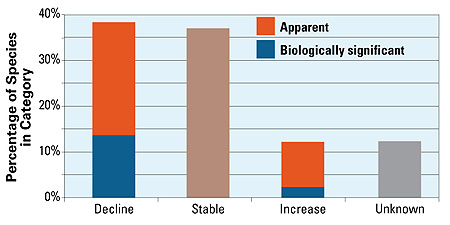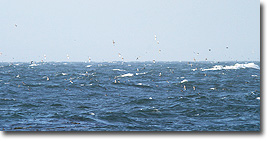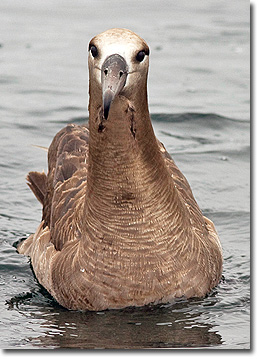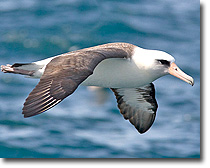Oceans
Far at Sea: Birds Face Hazards from Fishing, Pollution, and Altered Food Supplies
The State of Ocean Birds
|
|
Of 81 ocean bird species, almost half are of conservation concern,
including 4 that are federally listed as endangered or threatened.
Based on available data, 39% of ocean bird species are declining, 37%
stable, and 12% increasing. Too little data exist to determine the
population trends for 12% of ocean birds. There were insufficient data
to generate an indicator similar to those presented for other habitats
in this report, so trend categories were based on a variety of data
sets and expert opinion.
Trends for Ocean Bird Species

Birds in Trouble
 |
| Black-capped Petrel by Brian L. Sullivan |
Federally listed as endangered: Short-tailed Albatross, Hawaiian Petrel. Threatened: (Newell’s) Townsend’s Shearwater, Marbled Murrelet.
- Mortality from incidental capture in commercial fisheries (bycatch)
is the most significant source of mortality for Black-footed and Laysan
albatrosses, both species of high conservation concern.
- The Black-capped Petrel nests locally in the Caribbean and forages
off the eastern U.S. seaboard, but little is known about the population
size or threats to this rare species.
- The Ashy Storm-Petrel faces threats at its nesting colonies in
southern California and Baja California. In marine foraging areas, it
is vulnerable to contaminants, petroleum products, and plastics
encountered while foraging.
 |
Oceans may appear to be homogeneous but are composed of distinct habitats created by massive circulating currents. Human activity has affected the health of our oceans even far from land. Photo by Brian L. Sullivan |
Major Threats
 |
|
The Black-footed Albatross, a species |
Longline fisheries worldwide unintentionally injure and drown as many as 60 bird species, especially surface-feeding seabirds such as albatrosses.
Pollution
Pesticides, herbicides, heavy metals, and oil harm ocean
birds. Major oil spills kill thousands of birds, but small spills and
chronic releases from boats and ports also cause significant harm.
Many seabirds consume floating plastic and may feed it to their chicks. Ninety percent of Laysan Albatrosses surveyed on the Hawaiian Islands had plastic debris in their stomachs.
Climate Change
Sea-surface temperatures have risen up to 4 degrees Fahrenheit in the North Sea and are expected to continue increasing across the world’s oceans, affecting important food sources for ocean birds.
Breeding failures of some seabirds in northern latitudes have been attributed in part to increased pests and diseases that survive in warmer winters.
Kittlitz’s Murrelet population declines probably result from cyclical changes in the oceanic environment and glacial melting, affecting their ability to find food.
In addition to the threats noted above, ocean birds face challenges on their nesting grounds including development, disturbance, invasive species, and sea level rise. (See Hawaiian Islands and Coasts sections.)
 |
| Black-footed Albatross by Brian L. Sullivan |
Solutions
Fisheries laws provide the platform to ensure a sustainable ocean environment and can include provisions to reduce bycatch, orient marine fishery policy toward ecosystem management, and separate conservation and allocation decisions.
International efforts, such as the Agreement on the Conservation of Albatrosses and Petrels, can set a standard for cooperative management of seabirds.
Coordinated, regionwide programs are needed to collect, assess, and distribute data to better assess the status of seabird populations.
Increased monitoring of ocean birds and their food base are essential to measure change in ocean health and help develop more effective conservation actions.
Reasons for Hope
 |
| Laysan Albatross by Brian L. Sullivan |
Regulations and voluntary measures to minimize bycatch have been
established for U.S. fisheries in Alaska and Hawaii, resulting in
significant decreases in ocean bird mortality, especially for
Black-footed, Laysan, and Short-tailed albatross.
The recent protection of 335,561 square miles in four Marine National
Monuments will greatly improve the health of our oceans, benefiting
people as well as birds and other ocean life.













